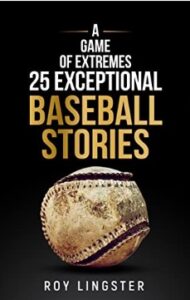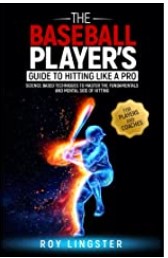 A Game of Extremes – 25 exceptional baseball stories about what happens on and off the field.
A Game of Extremes – 25 exceptional baseball stories about what happens on and off the field.
By Roy Lingster
Copyright, Roy Lingster, 2022
Paperback – $14.97, ebook – $5.99; both at Amazon.com
Audiobook – $14.95 at audible.com
My mother used to tell me, “If you can’t say something good about someone (or something), don’t say anything at all.” Well, given that philosophy, Baseball Roundtable has plenty to say (write) about Roy Lingster’s book “A Game of Extremes … 25 exceptional baseball stories about what happens on and off the field.” I highly recommend this enjoyable baseball read. Lingster brings new life and new perspectives (and twists) to some of baseball’s best stories (and characters). After reading these stories, you will likely have an urge to pass them on to your friends (perhaps even claiming them as your own).
Baseball Roundtable readers are familiar with the fact that as I explore baseball topics for this blog “one thing always seem to lead to another.” You’ll find that true in A Game of Extremes. In fact, Lingster pulled me in right off the bat. In Chapter One – The 168 MPH Fastball – Lingster linked the mythical Sidd Finch and the cinematic Nuke Laloosh to the enigmatic Steve Dalkowski, touted by many people close to the game as the hardest-throwing (fastest) pitcher ever. Ultimately, Dalkowski’s is a story of unfulfilled promise – promise of a level that has made Dalkowski, who never threw a pitch in a regular-season MLB game, a bit of a hardball legend.
In that first chapter, Lingster also unveils another “theme” that you’ll find through the book – the use of quotes from people who were there to help flesh out the stories. In telling Dalkowski ‘s tale, Lingster brings in Lou Brock, who once said “Grab your helmets, run behind buildings, because this guy throws unguided missiles and (even) he doesn’t know were they are going.”
Now, I don’t want to give away too much of the book, but I will provide some snippets of what you can expect. Here are a few examples:
- In the chapter on Satchel Paige, we learn that he honed his pitching skills in reform school. In Satchel’s words: “I traded five years of my freedom to learn how to pitch.”
- Lingster uses Babe Ruth’s often disputed “called shot,” to lead us into the story of Herman “Germany” Schaefer – best known for forcing a rules change by once stealing first base (from second), but who also has a documented “called shot” of his own.
- Lingster adds some depth into a look at Cy Young Award Winner Zack Greinke and both his battle with social anxiety and his initial desire to be an everyday player. As Lingster tells it, on first being told he was going to the major leagues as a pitcher, Greinke asked, “Do you think if we ask them, they would let me go back to Single-A and be a shortstop? I think I can be a pretty good shortstop.”
- In the chapter on the life of Rube Waddell (considered baseball’s zaniest star), readers discover why the Waddell quote “You can charm a manger, but you can’t hypnotize a walrus.” makes sense. Side note: Waddell’s career was so wild (and successful) multiple books have been written about it. The Roundtable recommends “Rube Waddell – The Zany, Brilliant Life of a Strikeout Artist” by Alan H. Levy and “Just a Big Kid – The Life and Times of Rube Waddell” by Paul Proia.
- Lingster’s chapter on Sandy Koufax leads off with the poetry of Dylan Thomas and a look at Mike Mussina’s last season – and includes this quote from Duke Snider, “When he first came up, he couldn’t throw a ball inside the batting cage.”
I particularly liked the chapter on Mark Belanger (whom Lingster informs readers was the most pinch-hit for player in MLB history) and the value and beauty of defense. In this one, author and sportswriter Pat Jordan is quoted: “Belanger would glide effortlessly after a grounder and welcome it into loving arms; scooping up the ball in a single easy motion, and bringing it to his chest for a moment’s caress before making his throw,”
Readers will also want to spend some time with Lingster’s chapter on PED’s – which takes you from Greek Gods and ancient Olympians to Pud Galvin and the Brown-Sequard Elixir to the era of “Greenies” to today’s PED controversy. It may not change your mind, but it will give you something to think about.
In this book, you will also read about: Ty Cobb’s distaste for the home run (and his ability to go yard when he wanted to make a point); the iconic Dave Bresnahan potato story; the tale of Dock Ellis and his LSD-fueled no-hitter; Bill “Spaceman” Lee and his love of the game; the legendary and so quotable Yogi Berra; the story behind baseball’s “Golden Sombrero; a look at the fiery Billy Martin; the Jackie Mitchell legend; and even an entire chapter on walk-off balks. Now, I didn’t touch on all you find here. For example, prose linking Mark Fidrych, Pete Reiser and Joe Charboneau or tying ambidextrous pitcher Pat Venditte to one-armed outfielder Pete Gray or noting Yasiel Puig’s lucky thirteenth attempt to leave Cuba. I could go on and on, but you get the idea, this is a fun read for baseball fans. Great stories, with new insights and details, told in lively prose – with, I believe, a knowing smile. I may just read it again.
 Also by Roy Lingster
Also by Roy Lingster
Oh, and for a bit of a twist at the end of this review: A Game of Extremes is written by a player and fan who developed his passion for the game not on American ballfields and in American ballparks – but in the Netherlands.
_____________________________
AN INTERVIEW WITH THE AUTHOR
 Roy Lingster, who has a degree in Sports and Exercise, is a military sports instructor in the Netherlands, where he was born and raised (and played ball). He has devoted 25 years to the game, as both a player and a coach, and refers to his passion for baseball as “a hobby that got out of hand.”
Roy Lingster, who has a degree in Sports and Exercise, is a military sports instructor in the Netherlands, where he was born and raised (and played ball). He has devoted 25 years to the game, as both a player and a coach, and refers to his passion for baseball as “a hobby that got out of hand.”
Baseball Roundtable conducted a brief interview with Lingster. Here’s what I learned.
_________
Roundtable: You indicate that you are a military sport instructor. Can you elaborate a bit on what that entails?
Lingster: Every soldier in the Dutch army receives sports lessons to stay physically and mentally fit. I have been assigned a unit in which I provide different lessons five days a week – focusing on such areas as strength, endurance and coordination.
_____
The Roundtable: At what levels did you play and/or coach baseball – and where?
Lingster: When I was young, I always played at the highest level in the Netherlands. The high point at that time was the Little League World Series in 2007. When I turned 16, I had to make a career choice to study. Earning a living with baseball is not really an option in the Netherlands. Since that time, I mainly play in Netherlands’ Second Klasse. You have, in the Netherlands, hoofdklasse (highest level), then 1ste Klasse and then 2e Klasse. We call it the aluminum hoofdklasse because it is the highest class after the competition with wood bats.
_____
The Roundtable: What first brought you to the national pastime, and what about baseball made it an enduring passion?
Lingster: My parents were among the first members of the baseball club (association) in our district 50 years ago. I had no choice but to play baseball (ha, ha). While some may think baseball is boring to watch, those people don’t get it. It is one of the most mental sports out there. You have to be physically and mentally on the same page to be good at the game. I think that challenge is the best thing there is. And, understanding that challenge, draws you deeper and deeper into the game.
_____
The Roundtable: You bring a unique perspective to many of your stories … whether it’s references to Greek mythology, classic poetry or movie quotes. What drives – or how do you develop – these connections?
Lingster: That’s hard to say, I just do that automatically when I read stories. I just tend to see links with other stories or events.
_____
The Roundtable: What are some of your favorite sources of information on American baseball?
Lingster: Hmm. This sounds really stupid, but everything started with YouTube. After that it’s been just digging in.
Baseball Roundtable note: Lingster is being a bit modest here. Just glancing through the footnotes, I found sources listed by Lingster to include not only YouTube videos, but archived articles from a range of newspapers and magazines; more than a dozen baseball books; and information (primarily from websites) from organizations like The Smithsonian, Baseball Hall of Fame, ESPN and National Public Radio; as well as from sportsanddrugs.procon.com; baseball-reference.com; MLB.com; and even the 1990 Baseball Card Engagement Book.
For the Baseball Roundtable Book Review Archive, click here. You’ll find more than two dozen reviews.
 Baseball Roundtable is on the Feedspot list of the Top 100 Baseball Blogs. To see the full list, click here.
Baseball Roundtable is on the Feedspot list of the Top 100 Baseball Blogs. To see the full list, click here.
I tweet baseball @DavidBBRT
Follow/Like Baseball Roundtable’s Facebook Page here. More baseball commentary; blog post notifications; PRIZES.
Member: Society for American Baseball Research (SABR); Negro Leagues Baseball Museum; The Baseball Reliquary.





